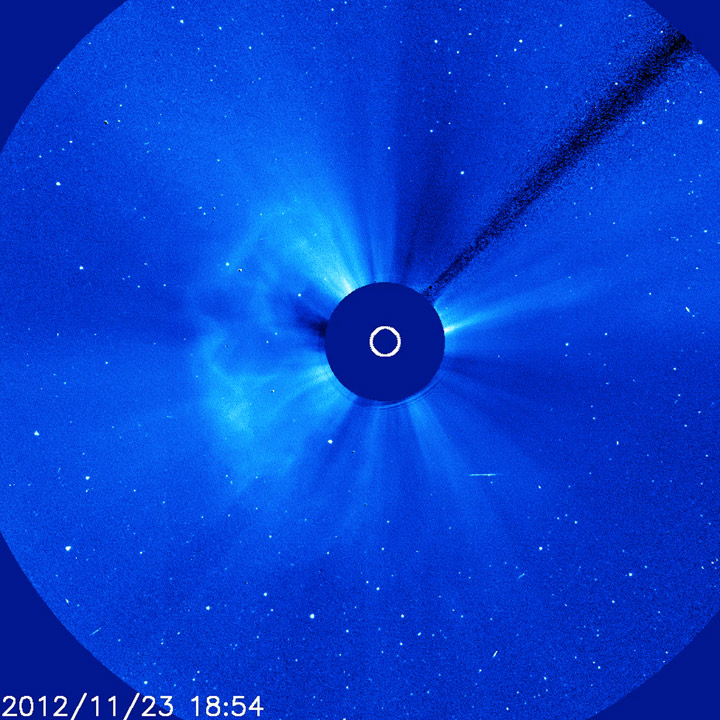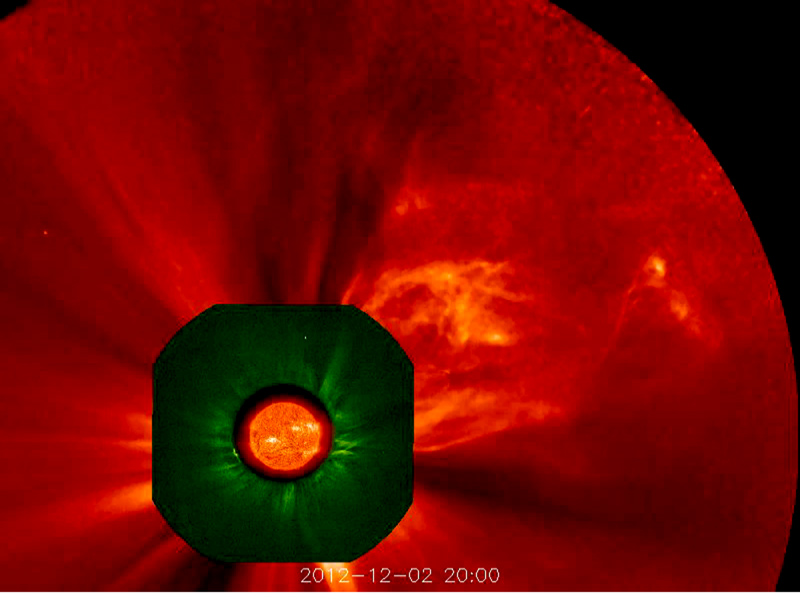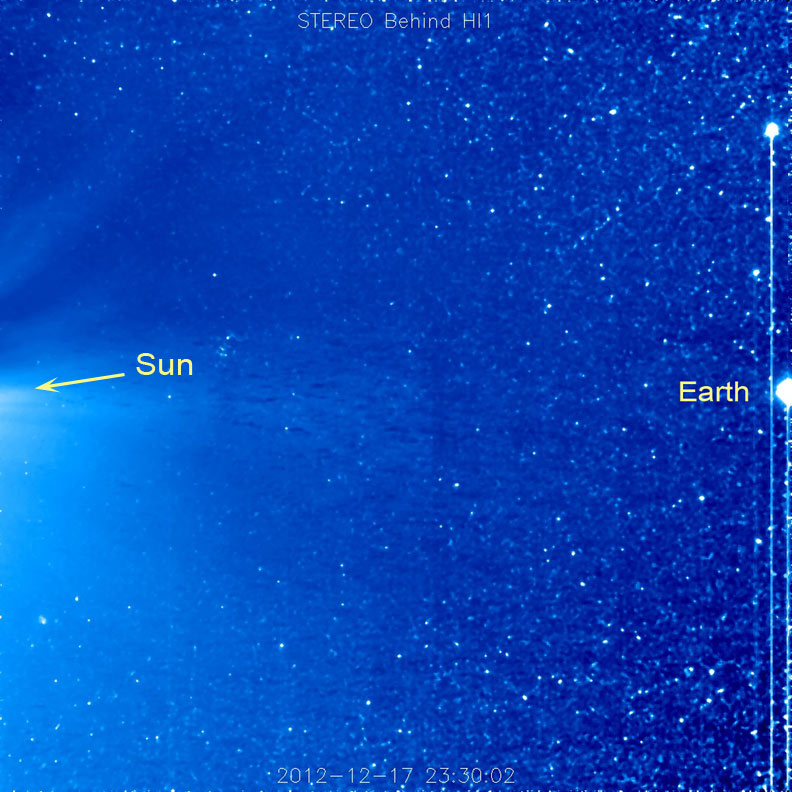Halo CMEs? We Got 'Em (2012 Nov 30)
The Sun spewed out about a dozen coronal mass ejections (CMEs) over a six-day period (Nov. 18-24, 2012), and several of them were "halo" CMEs in which the leading edge of the particle clouds seem to expand in a roughly circular shape around the Sun, not because it surrounds the Sun, but because it is moving directly toward or away from the observer. The frequency of these storms is typical of solar activity as we move closer to its period of solar maximum.
Credit: NASA/ESA/SOHO
<< Previous SOHO
SOHO: Pick of the Week (2012 Nov 30 - Dec 21)
SOHO: Pick of the Week (2012 Nov 30 - Dec 21)
Know the quiet place within your heart and touch the rainbow of possibility; be
alive to the gentle breeze of communication, and please stop being such a jerk. — Garrison Keillor
alive to the gentle breeze of communication, and please stop being such a jerk. — Garrison Keillor
Re: SOHO: Pick of the Week (2012 Nov 30 - Dec 21)
Double-Barrel Action (2012 Dec 07)
The Sun blasted out two coronal mass ejections (CMEs) in quick succession over a 12-hour period (Dec. 2, 2012). The events are presented here by three of STEREO's (Ahead) instruments composited together. The Sun itself (shown in orangish-red) is seen in extreme UV light; the inner corona (green) by the COR1 coronagraph; and the larger coronal area by the COR2 coronagraph. The CME particle clouds were directed away from Earth.
Credit: NASA/ESA/SOHO
The Sun blasted out two coronal mass ejections (CMEs) in quick succession over a 12-hour period (Dec. 2, 2012). The events are presented here by three of STEREO's (Ahead) instruments composited together. The Sun itself (shown in orangish-red) is seen in extreme UV light; the inner corona (green) by the COR1 coronagraph; and the larger coronal area by the COR2 coronagraph. The CME particle clouds were directed away from Earth.
Credit: NASA/ESA/SOHO
Know the quiet place within your heart and touch the rainbow of possibility; be
alive to the gentle breeze of communication, and please stop being such a jerk. — Garrison Keillor
alive to the gentle breeze of communication, and please stop being such a jerk. — Garrison Keillor
Re: SOHO: Pick of the Week (2012 Nov 30 - Dec 21)
Bright Prominence Eruption (2012 Dec 14)
The Sun blows a robust prominence out into space (Dec. 10, 2102). The outer image, from the STEREO-A's COR1 coronagraph, has been changed from green to red to complement the green Sun image, taken in extreme UV light. The movie covers six hours of activity. Kind of Christmassy looking, isn't it? Some of the prominence falls back towards the sun, although the disturbance as a whole continues out into the solar system.
Credit: NASA/ESA/SOHO/STEREO
The Sun blows a robust prominence out into space (Dec. 10, 2102). The outer image, from the STEREO-A's COR1 coronagraph, has been changed from green to red to complement the green Sun image, taken in extreme UV light. The movie covers six hours of activity. Kind of Christmassy looking, isn't it? Some of the prominence falls back towards the sun, although the disturbance as a whole continues out into the solar system.
Credit: NASA/ESA/SOHO/STEREO
Know the quiet place within your heart and touch the rainbow of possibility; be
alive to the gentle breeze of communication, and please stop being such a jerk. — Garrison Keillor
alive to the gentle breeze of communication, and please stop being such a jerk. — Garrison Keillor
Re: SOHO: Pick of the Week (2012 Nov 30 - Dec 21)
Earth now visible in STEREO (2012 Dec 21)
STEREO Behind's Inner Heliospheric Imager
The STEREO Behind spacecraft has now moved far enough in its orbit for Earth to enter the HI1-B field-of-view. Earth has been visible in the HI2 telescopes since launch, but this is the first time it's been visible in either of the HI1 telescopes, which image areas closer to the Sun. This is happening because the STEREO spacecraft are moving closer to the points in their orbits at which they will be directly opposite Earth on the other side of the Sun.
In the above image, Earth is the object at the center right edge. The bright object near the upper-right corner is the bright star Pollux (β Gem). Soon Earth will be visible in STEREO Ahead's HI1 and eventually in the coronagraphs. In 2015 the Earth will pass behind the Sunfrom the point of view of the two spacecraft.
Credit: NASA/ESA/SOHO/STEREO
http://stereo.gsfc.nasa.gov/gallery/ite ... aft&iid=34
http://stereo.gsfc.nasa.gov/classroom/secchi_fov.shtml
STEREO Behind's Inner Heliospheric Imager
The STEREO Behind spacecraft has now moved far enough in its orbit for Earth to enter the HI1-B field-of-view. Earth has been visible in the HI2 telescopes since launch, but this is the first time it's been visible in either of the HI1 telescopes, which image areas closer to the Sun. This is happening because the STEREO spacecraft are moving closer to the points in their orbits at which they will be directly opposite Earth on the other side of the Sun.
In the above image, Earth is the object at the center right edge. The bright object near the upper-right corner is the bright star Pollux (β Gem). Soon Earth will be visible in STEREO Ahead's HI1 and eventually in the coronagraphs. In 2015 the Earth will pass behind the Sunfrom the point of view of the two spacecraft.
Credit: NASA/ESA/SOHO/STEREO
http://stereo.gsfc.nasa.gov/gallery/ite ... aft&iid=34
http://stereo.gsfc.nasa.gov/classroom/secchi_fov.shtml
Know the quiet place within your heart and touch the rainbow of possibility; be
alive to the gentle breeze of communication, and please stop being such a jerk. — Garrison Keillor
alive to the gentle breeze of communication, and please stop being such a jerk. — Garrison Keillor



